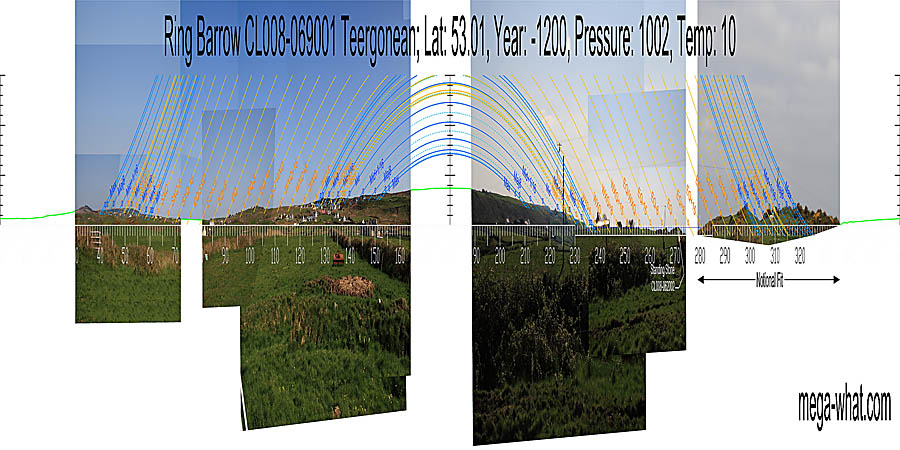 Ring Barrow CL008-069001 is above Doolin village, to the north of the road that runs up to the R478. It has only had one quick visit and the survey is far from complete.
Ring Barrow CL008-069001 is above Doolin village, to the north of the road that runs up to the R478. It has only had one quick visit and the survey is far from complete.
South is on the hilltop [Pic]. Green lines approximate hidden horizon segments.
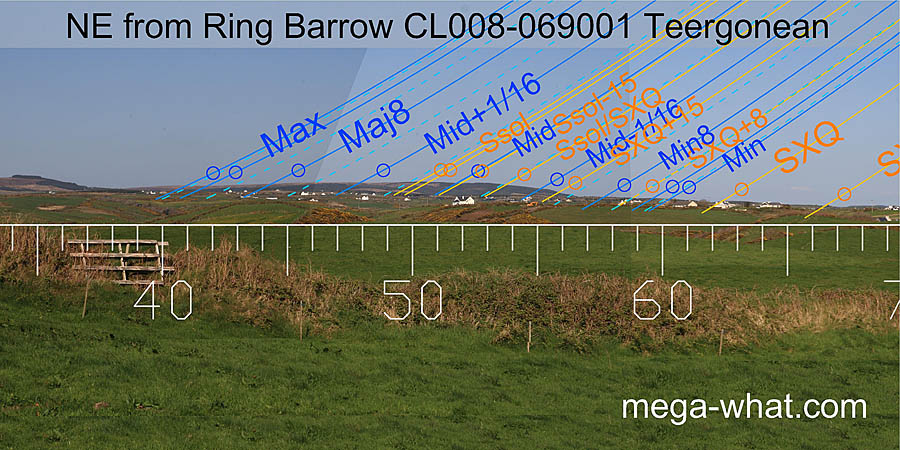 To the north-east a ridge of higher ground provides markers for the northerly rises of sun and moon with the solstice at the highest point.
To the north-east a ridge of higher ground provides markers for the northerly rises of sun and moon with the solstice at the highest point.
 To the east is a prominent hill. The equinox is at its north basal step while the summit is a half-month further south.
To the east is a prominent hill. The equinox is at its north basal step while the summit is a half-month further south.
There are other useful correspondences but they are much more subtle ones.
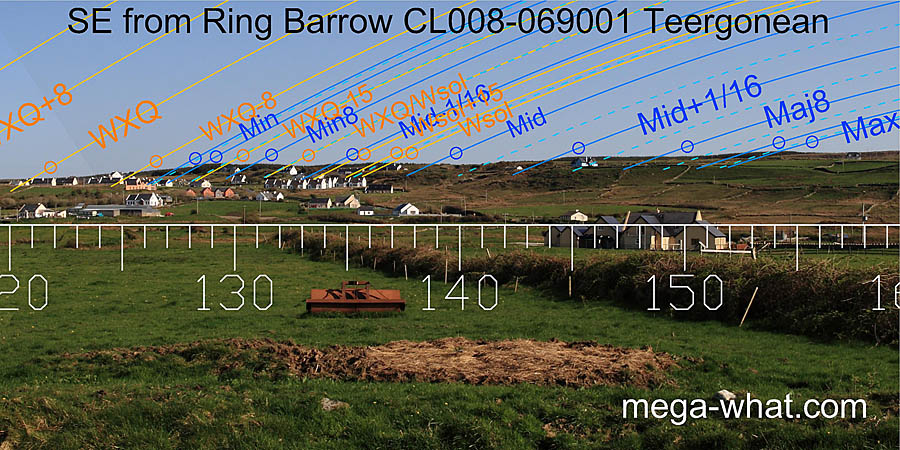 The south-eastern horizon is complicated by forestry and buildings but the solstice and both lunar
standstillsLunistice positions vary cyclically over an 18.6 year period but are fairly static for more than a year at either end of the range
would appear to involve high points. The solstice/cross-quarter midpoint is in a dip.
The south-eastern horizon is complicated by forestry and buildings but the solstice and both lunar
standstillsLunistice positions vary cyclically over an 18.6 year period but are fairly static for more than a year at either end of the range
would appear to involve high points. The solstice/cross-quarter midpoint is in a dip.
 The stepped south-western horizon seems to have been configured to optimise sunsets and the minor end of the
lunisticeLunistices are the most northerly and southerly moons of the month. The lunar equivalent of solstices - more.
range. The solstice is on the flat at the top of a slope and the upper limb of its half-month bracket runs down a sloping step.
The solstice/cross-quarter midpoint is also at a step and the cross-quarter's half-month bracket is at the land/sea intersect.
The minor standstillLunistice positions vary cyclically over an 18.6 year period but are fairly static for more than a year at either end of the range
and its adjacent sixteenth are at the southern edge of the sea horizon, then the eighth and the next sixteenth are both along the slopes of significant steps.
The stepped south-western horizon seems to have been configured to optimise sunsets and the minor end of the
lunisticeLunistices are the most northerly and southerly moons of the month. The lunar equivalent of solstices - more.
range. The solstice is on the flat at the top of a slope and the upper limb of its half-month bracket runs down a sloping step.
The solstice/cross-quarter midpoint is also at a step and the cross-quarter's half-month bracket is at the land/sea intersect.
The minor standstillLunistice positions vary cyclically over an 18.6 year period but are fairly static for more than a year at either end of the range
and its adjacent sixteenth are at the southern edge of the sea horizon, then the eighth and the next sixteenth are both along the slopes of significant steps.
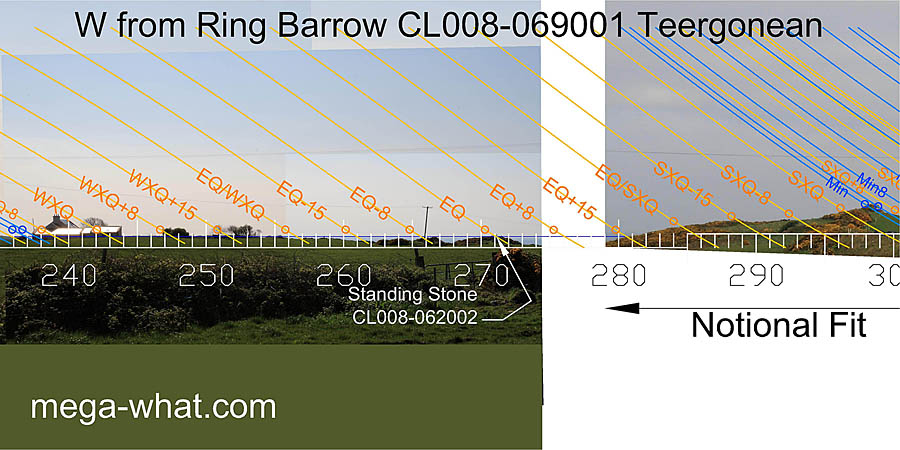 Westwards, about 210m away, an unlisted Standing Stone (IR 08021 ITM 96763) near barrow CL008-067 cuts the sea horizon
to mark a declination of -7.5°.
Westwards, about 210m away, an unlisted Standing Stone (IR 08021 ITM 96763) near barrow CL008-067 cuts the sea horizon
to mark a declination of -7.5°.
Standing stone CL008-062002 on top of Stepped Barrow CL008-062001, is a further 365m away and marks the equinox exactly.
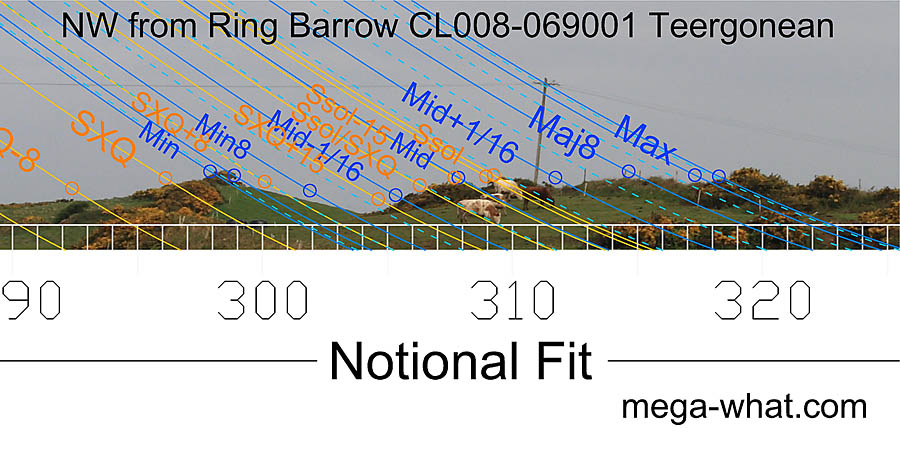 The north-west is unsurveyed and this patched in view is from Ring Barrow CL008-071, just 130m to the south-east.
The north-west is unsurveyed and this patched in view is from Ring Barrow CL008-071, just 130m to the south-east.
Unsurveyed Ring Barrow CL008-069002 is on this horizon about 35m away. Major standstillLunistice positions vary cyclically over an 18.6 year period but are fairly static for more than a year at either end of the range falls within it.
Also unsurveyed is Ring Barrow CL008-067, 240m to the west.
References
- Archaeological Survey of Ireland, record details. www.archaeology.ie/archaeological-survey-ireland
